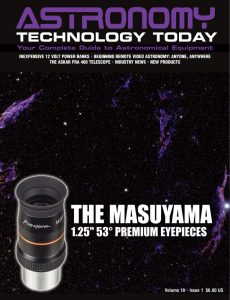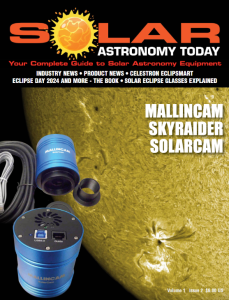The NebuNoise Astrophotography Software platform is a new AI-driven software system created for astrophotographers, aimed at enhancing the quality of night sky images by reducing noise without losing detail. Released in beta, it is a standalone tool and it fits smoothly into any editing workflow, offering specialized noise reduction without tying users to a specific editing platform. It uses convolutional neural networks (CNNs) to clean up photos, combining sophisticated technology with an easy-to-use interface.
 As the publisher notes, “The aim of this project is to provide users with an affordable, standalone AI noise reduction tool that doesn’t tie users to a certain editing platform.”
As the publisher notes, “The aim of this project is to provide users with an affordable, standalone AI noise reduction tool that doesn’t tie users to a certain editing platform.”
Key features of the NebuNoise Astrophotography Software platform include:
– AI-Driven Denoising: Take advantage of AI algorithms trained on astrophotography, NebuNoise can distinguish between noise and the fine details of deep sky objects, ensuring the quality of your images is preserved.
– Standalone Utility: Its standalone nature allows NebuNoise to be a part of your editing process, compatible with any other photo editing software you prefer for subsequent adjustments.
– User-Friendly Interface: Designed to be accessible, NebuNoise caters to all skill levels, ensuring an easy-to-navigate denoising process.
– Workflow Integration: Easily integrate denoised images into your existing editing workflow, thanks to NebuNoise’s compatibility with a wide range of photo editing tools.
– Detail Preservation: The software’s precision ensures that while it effectively reduces noise, the defining details of your astrophotography remain sharp and clear.
As the publisher notes about the beta release, “As this is a beta, there are certain things to keep in mind. The program only accepts stretched 32-bit RGB FITS images. I am testing a version that works with linear images and plan on supporting 8-32 bit rgb/mono fits/tiff files. There is no CUDA acceleration yet. I am testing a method to replace the library folder for PyTorch that allows use with CUDA 11.8. The sharpening functionality is in an incomplete form. It works, but not as well as I would like it to. There are also some things I plan on adding to the program like a preview window.”
How Convolutional Neural Networks Work
The effectiveness of the NebuNoise Astrophotography Software platform is not just in its technology but also in its design. The application provides users with a standalone environment with intuitive controls to adjust the denoising and sharpening intensity, allowing for a specialized denoising process that meets the specific needs of each image.
NebuNoise utilizes Convolutional Neural Networks (CNNs) in image denoising. CNNs are a specialized kind of neural network that is particularly good at working with images. They handle spatial information well because they’re made up of layers, each designed for a specific job. In the beginning, CNNs use what’s called convolutional layers, which have a set of filters. These filters are tuned to pick up on basic parts of the image like edges and textures in different directions and sizes. This step is about finding the key parts of the picture that are crucial for cleaning up the image later.
After picking out these features, CNNs then use pooling layers to simplify the image. This means they reduce the size of the image’s feature maps, which makes the data more manageable and less detailed. Doing this makes the CNN more efficient since there is less information to work with, and it also helps the network be more reliable when dealing with changes or noise in the images it processes. This process can be repeated many times after each instance of size reduction.
The strength of CNNs in denoising applications lies in their hierarchical structure, where lower layers capture basic image features such as edges and textures, while deeper layers can identify more complex patterns. This hierarchical feature extraction makes CNNs efficient in distinguishing noise from actual image content, which is crucial for preserving astrophotography images where every detail counts.
CNNs initiate their task by using convolutional layers, which are like a set of special filters that scan the image to identify basic patterns like lines, edges, and areas of contrast. These filters move across the image in a systematic manner, capturing important visual information and creating maps that highlight these features at various points in the image.
Pooling layers are integrated between the convolutional layers in CNNs to perform downsampling. This process simplifies the feature maps by reducing their size, which in turn, diminishes the network’s focus on the precise position of the smaller details and allows it to concentrate on the broader, more significant patterns. Downsampling is beneficial for denoising as it prevents the network from mistaking minor noise for important image details and also streamlines the computation, allowing the network to handle larger images or operate on less powerful devices.
The capability of CNNs to discern between noise and actual image content improves as they are trained on a diverse set of images, some with noise and others without. The network fine-tunes the filters to enhance their ability to isolate the signal from the noise with each training iteration.
For astrophotography, where subtle details can be obscured by noise, the CNN’s ability to learn from various examples is essential. NebuNoise is specifically tuned to recognize common types of noise encountered in astronomical imagery, allowing for precise noise reduction.
The concluding layers of a CNN, which typically include fully connected layers, are responsible for reconstructing the image from the processed features. This reconstruction is informed by the hierarchy of features the network has identified as essential, omitting the noise.
In NebuNoise, the output from these layers results in the creation of a denoised astrophotography image. The network has been trained to ignore noise, which means it can produce an image that retains the details necessary for a high-quality astro photo. This ensures that the objects within the image are represented with both clarity and precision.
The neural network within NebuNoise is trained to specialize specific scenarios that will be encountered during astrophotography. It uses a dataset of high-quality, clean images from Hubble and James Webb. In its training phase, the network is fed with these clear images, to which noise is artificially added. This creates a training environment that mimics the different types of noise commonly found in astro images. This training process ensures that the network becomes effective at recognizing and filtering out various kinds of noise, all while maintaining the important details that are essential for our images.
You can learn more about the NebuNoise Astrophotography Software platform here.

 And to make it easier for you to get the most extensive news, articles and reviews that are only available in the magazine pages of Astronomy Technology Today, we are offering a 1-year magazine subscription for only $6! Or, for an even better deal, we are offering 2 years for only $9. Click here to get these deals which only will be available for a very limited time. You can also check out a free sample issue here.
And to make it easier for you to get the most extensive news, articles and reviews that are only available in the magazine pages of Astronomy Technology Today, we are offering a 1-year magazine subscription for only $6! Or, for an even better deal, we are offering 2 years for only $9. Click here to get these deals which only will be available for a very limited time. You can also check out a free sample issue here.
The Sun is more active than it’s been in years and if that’s not enough, we have the upcoming Total Solar Eclipse on April 8, 2024! If you’d like to learn more about the technology behind solar observing, solar imaging and more, you can check out our new monthly magazine – Solar Astronomy Today. It’s free to read, no subscription needed and available here. And if you are preparing for the upcoming eclipses and want to know your equipment options from solar glasses to the most out of this world solar viewing and imaging options, check out our free publication – The Definitive Guide to Viewing and Imaging the Sun – simply click here and enjoy reading!

